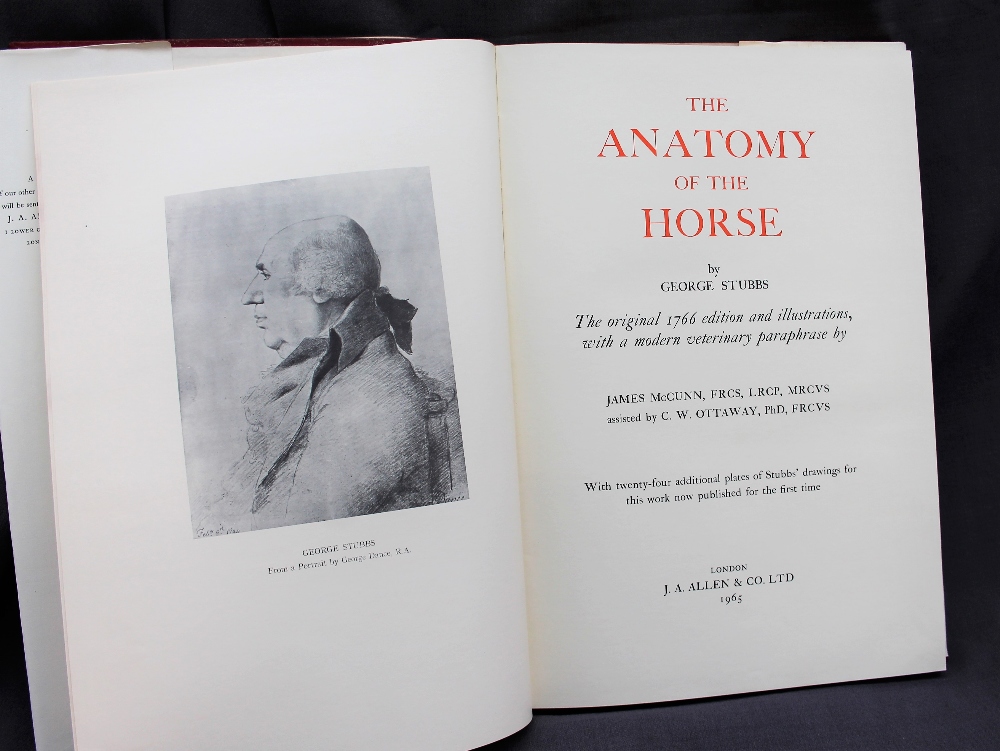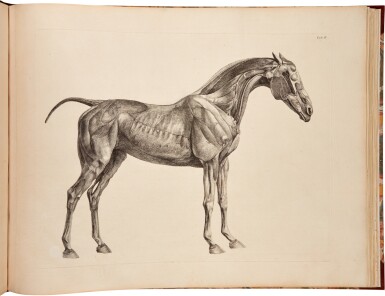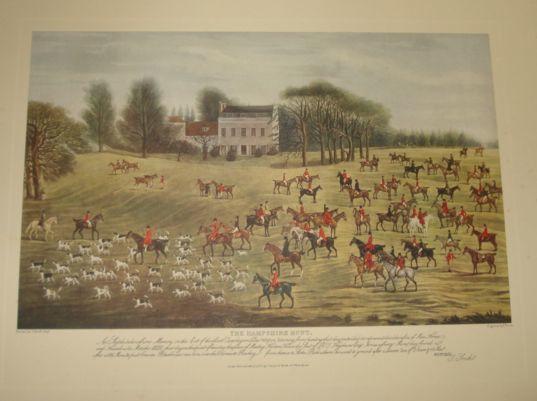STUBBS, George (1724-1806). The Anatomy of the Horse, Including a Particular Description of the Bones, Cartilages, Muscles, Fascias, Ligaments, Nerves, Arteries, Veins, and Glands . London: Printed by J. Purser, for the Author, 1766. Oblong broadsheets (445 x 565 mm). Letterpress title-page, "To the Reader" leaf and 47 pages text. 24 etched plates by Stubbs. (Some general light offsetting and spotting, old vertical creases to title and front free endpaper, some other soft handling creases.) Original green quarter polished calf, marbled boards, original publisher's paper label on front cover (label lightly soiled, hinges weak). FIRST EDITION, IN THE ORIGINAL BOARDS, later issue (plates watermarked 1815). A LANDMARK STUDY OF EQUINE ANATOMY, and one of a number of books which can be said to have "revolutionized men's understanding of the natural world" (Lennox-Boyd). Ray describes the etchings as having a "fine exactness and austere beauty" that "give them a timeless beauty." Stubbs executed the drawings over the course of 18 months, keeping each carcass in his studio for as long as six or seven weeks. He taught himself to etch in order to finish the work, as he had been unable to find an engraver. "The work appeared in 1766, and remained the standard authority on the subject for nearly a century ... In 1771, ... Camper ... whose work on the relationship of art to anatomy had won international recognition, wrote to Stubbs comparing his work with that of the great Albinus, whose Tabulae Sceleti et Musculorum Corporis Humani had appeared in 1749. It is entirely appropriate to rank The Anatomy of the Horse with Thomas Pennant's British Zoology (1770) and Gilbert White's Natural History of Selbourne (1789), among the most important of the several works of this time which, by emphasising the importance of precise systematic observation, revolutionised men's understanding of the natural worlds" (Lennox-Boyd). Dingley 600; Eales (Cole) 1840; Huth p.42; Lennox-Boyd pp.165-88; Mellon Books on Horse and Horsemanship 57; Nissen ZBI 4027; Ray p.6; Sparrow pp.165-188.
STUBBS, George (1724-1806). The Anatomy of the Horse, Including a Particular Description of the Bones, Cartilages, Muscles, Fascias, Ligaments, Nerves, Arteries, Veins, and Glands . London: Printed by J. Purser, for the Author, 1766. Oblong broadsheets (445 x 565 mm). Letterpress title-page, "To the Reader" leaf and 47 pages text. 24 etched plates by Stubbs. (Some general light offsetting and spotting, old vertical creases to title and front free endpaper, some other soft handling creases.) Original green quarter polished calf, marbled boards, original publisher's paper label on front cover (label lightly soiled, hinges weak). FIRST EDITION, IN THE ORIGINAL BOARDS, later issue (plates watermarked 1815). A LANDMARK STUDY OF EQUINE ANATOMY, and one of a number of books which can be said to have "revolutionized men's understanding of the natural world" (Lennox-Boyd). Ray describes the etchings as having a "fine exactness and austere beauty" that "give them a timeless beauty." Stubbs executed the drawings over the course of 18 months, keeping each carcass in his studio for as long as six or seven weeks. He taught himself to etch in order to finish the work, as he had been unable to find an engraver. "The work appeared in 1766, and remained the standard authority on the subject for nearly a century ... In 1771, ... Camper ... whose work on the relationship of art to anatomy had won international recognition, wrote to Stubbs comparing his work with that of the great Albinus, whose Tabulae Sceleti et Musculorum Corporis Humani had appeared in 1749. It is entirely appropriate to rank The Anatomy of the Horse with Thomas Pennant's British Zoology (1770) and Gilbert White's Natural History of Selbourne (1789), among the most important of the several works of this time which, by emphasising the importance of precise systematic observation, revolutionised men's understanding of the natural worlds" (Lennox-Boyd). Dingley 600; Eales (Cole) 1840; Huth p.42; Lennox-Boyd pp.165-88; Mellon Books on Horse and Horsemanship 57; Nissen ZBI 4027; Ray p.6; Sparrow pp.165-188.













Try LotSearch and its premium features for 7 days - without any costs!
Be notified automatically about new items in upcoming auctions.
Create an alert